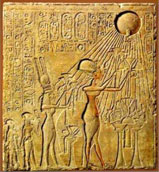The Sun in Ancient Times
Cave paintings indicate that the cave man believed exposure to sunlight was necessary for good health.
Medical practitioners in the time of the Egyptian pharaohs reported the benefits of sun exposure. A famous hieroglyphic shows the Pharaoh Akhenaton with Queen Nefertiti and their children being blessed by the hands of the sun (see below).
Sun therapy was praised by Hippocrates who was widely considered to be the “Father of Medicine” and the creator of the Hippocratic Oath.
Ancient people instinctively understood that sunshine was beneficial. But in modern man, Vitamin D deficiency is becoming common, even in Australia, due to the popularity of sun avoidance practices and our modern indoor lifestyle.

Vitamin D & the Wild Kingdom
Animals and reptiles can also suffer from Vitamin D deficiency when they are shaded and protected from sun in zoos or kept as pets.
Kirmani, a gorilla born at Franklin Park Zoo in Boston showed signs of soft bones and had severe muscle weakness at 7 months. Once she was given Vitamin D supplements she made a full recovery.
Twin polar bears at the Denver Zoo had difficulty walking until they were given Vitamin D supplements.
The first Komodo dragons kept in a zoo in the United States were a gift by the president of Indonesia to the National Zoo in Washington. They risked signs of dying out as they were unable to produce viable hatchlings. But when their Vitamin D was increased, a new generation of Komodo dragons were born.
Often young reptiles kept as family pets show signs of the bone softening disease rickets, while the older reptiles may have osteoporosis and develop a sway back and fractures. Reptiles can’t make Vitamin D from the sun when they live in a glass fish tank because UVB can’t get through glass.